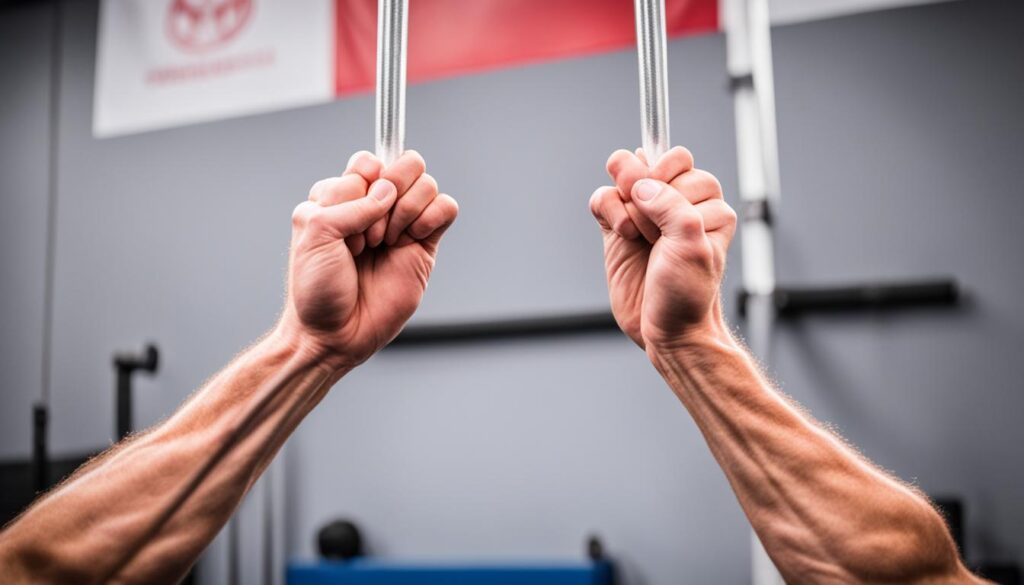Pole vaulting is an exhilarating and challenging sport that combines skill, speed, and mental determination. Whether you’re a beginner or an experienced vaulter, it’s important to have the right techniques and training strategies to excel in this event.
In this comprehensive guide, we will cover essential pole vaulting tips and techniques that will help you improve your performance. From mastering the proper grip and carry to executing the perfect plant and takeoff, we’ll break down each phase of the jump to ensure you have a solid understanding of the fundamentals.
Additionally, we will outline training strategies and exercises to enhance your strength, speed, and overall athletic ability. With the right coaching and consistent training, you can reach new heights in pole vaulting.
Key Takeaways:
- Proper technique is crucial for a successful and safe pole vault.
- The grip and pole carry position play a vital role in executing proper technique.
- The approach run sets the foundation for a successful jump.
- The plant, takeoff, swing, row, extension, and clearance are key phases of the jump.
- Training design should focus on improving weaknesses and developing specific strength and speed.
The Importance of Proper Technique in Pole Vaulting
Proper technique is crucial in pole vaulting to ensure a successful and safe jump. Athletes must master various elements of technique, including grip, pole positioning, and body alignment, to maximize their performance. By honing these skills, pole vaulters can achieve greater heights and minimize the risk of injury.
One of the key aspects of proper technique in pole vaulting is the grip. The vaulter’s grip on the pole determines their control and ability to generate upward momentum. It is essential to find the ideal grip width that matches the individual’s shoulder width for a balanced and efficient vault. The top hand should grip the pole with the palm facing upward, while the bottom hand should assume a grip with the palm down. Training drills can help athletes develop a strong and consistent grip, leading to improved performance.
Another critical aspect of proper technique is the correct positioning of the pole in relation to the vaulter’s body. The pole should be aimed at the back and bottom of the box, allowing for optimal energy transfer during the jump. Additionally, the vaulter should extend their body as much as possible to keep the pole as straight as they can, maximizing the conversion of horizontal speed to vertical momentum.
To execute a successful pole vault, the vaulter must master the art of reaching maximum height before clearing the crossbar. This requires maintaining consistent form during the run-up, executing an explosive take-off, and timing the arch over the bar precisely. Proper technique ensures efficient energy transfer and allows the athlete to reach their full potential in the event.
In the words of Olympic champion Renaud Lavillenie, “Perfecting your technique is the key to unlocking your true potential in pole vaulting. Every small adjustment and improvement can make a significant difference in your performance.”
Benefits of Proper Technique in Pole Vaulting
| Benefits | Description |
|---|---|
| Improved Performance | Proper technique allows athletes to generate maximum energy transfer for higher jumps and improved results. |
| Reduced Injury Risk | Following the correct technique helps minimize the risk of strain, sprain, or other pole vaulting-related injuries. |
| Consistency | Mastering proper technique ensures a consistent approach and execution, leading to reliable performance in competition. |
| Higher Success Rate | By adhering to proper technique, athletes increase their chances of clearing higher bars successfully and achieving personal bests. |
The Grip in Pole Vaulting

In the thrilling sport of pole vaulting, a proper grip is crucial for maintaining control and executing the perfect technique. The grip determines how the vaulter interacts with the pole, allowing them to generate the necessary power for a successful jump.
When gripping the pole, the width should be approximately equal to the distance between the vaulter’s shoulders. This ensures a balanced and comfortable grip, providing stability throughout the jump.
The grip itself differs between the top and bottom hand. The top hand should grip the pole with the palm facing upward. This grip allows for better control and helps the vaulter guide the pole throughout the jump. On the other hand, the bottom hand should assume a grip with the palm down, facilitating a secure hold and ensuring proper alignment.
Coaches often use various drills to teach the correct grip. One such drill involves gripping the pole with just the top hand to practice control and hand placement. Another effective drill is holding the pole horizontally across the body, teaching the vaulter to maintain a consistent grip while executing different positions.
With a strong and consistent grip, pole vaulters can confidently tackle the challenges of the sport, reaching new heights with each jump.
Pole Vault Grip Drills
| Drill | Description |
|---|---|
| Top Hand Only Grip | The vaulter grips the pole using only the top hand, practicing control and proper hand placement. |
| Horizontal Hold | The vaulter holds the pole horizontally across the body, maintaining a consistent grip while executing different positions. |
| One-Handed Grips | The vaulter practices gripping the pole with each hand individually, improving control and grip strength. |
| Finger Hold | The vaulter uses only their fingers to grip the pole, focusing on finger strength and dexterity. |
The Pole Carry in Pole Vaulting
The pole carry position plays a crucial role in achieving a smooth and effective approach run in pole vaulting. It determines the initial positioning of the pole and sets the foundation for a successful jump. Understanding the correct technique for carrying the pole is essential for the vaulter’s overall performance and safety.
To carry the pole effectively, the vaulter should focus on the position of their top and bottom hands. The top hand should be positioned near the top of the right hip, hooking the top of the pole securely. This position allows for better control and balance throughout the approach run. Meanwhile, the bottom hand should be straight or slightly cocked back, with the wrist positioned approximately 4-6 inches from the chest. By maintaining this distance, the vaulter can optimize their grip and maintain control of the pole during the jump.
The distance between the hands may vary slightly depending on the athlete’s personal preference and body proportions. Some vaulters may feel more comfortable with a wider grip, while others may prefer a narrower grip. Experimenting with hand placement can help determine the most efficient and effective configuration for each individual vaulter.
During the approach run, it’s important to maintain a slight up and down movement of the pole. This movement helps generate momentum and rhythm, enabling the vaulter to smoothly transition from the approach run to the takeoff. Avoiding back and forth seesawing movements is crucial to maintaining stability and control throughout the jump.
Key points:
- Top hand: Positioned near the top of the right hip, hooking the top of the pole.
- Bottom hand: Straight or slightly cocked back, with the wrist approximately 4-6 inches from the chest.
- Distance between hands: May vary between athletes based on personal preference and body proportions.
- Up and down movement: Maintain a slight up and down movement of the pole during the approach run.
- Avoiding seesawing: Prevent back and forth seesawing movements to maintain stability and control.
By mastering the proper pole carry technique, vaulters can enhance their approach run and set themselves up for a successful jump. Consistent practice and attention to detail in this fundamental aspect of pole vaulting can make a significant difference in overall performance.
The Approach Run in Pole Vaulting

The approach run is a critical component of successful pole vaulting. It serves as the foundation for a powerful and controlled jump. To execute a proper approach run, athletes must focus on maintaining a consistent stride pattern while generating sufficient speed and power.
The length of the approach run may vary based on factors such as the athlete’s ability level, technical proficiency, training age, and competition age. It’s important to find the optimal distance that allows for a smooth transition into the plant and take-off phases.
During the approach run, athletes should start with an appropriate pattern of acceleration during the drive phase. This phase involves gradually increasing speed while maintaining proper form and technique. Stride mechanics play a crucial role in maintaining balance and generating momentum.
“The approach run sets the tone for the entire pole vault. Getting the right rhythm and pace is essential for a successful jump.” – Coach Sarah Johnson
The continuation phase of the approach run focuses on maintaining stride mechanics and rhythm. Athletes should steer clear of overstriding or rushing, as this can lead to loss of control and reduced power. Stride length and frequency should be consistent and comfortable.
The transition phase is the final part of the approach run and functions as a preparation for the plant and take-off. Athletes should aim to maintain controlled movement and position themselves for a smooth transition into the subsequent phases of the jump.
Key Points for the Approach Run:
- Maintain a consistent stride pattern
- Generate sufficient speed and power
- Fine-tune acceleration during the drive phase
- Focus on maintaining proper stride mechanics
- Prepare for a smooth transition into the plant and take-off
The approach run is a crucial element of pole vaulting that requires precision, technique, and practice. By mastering the approach, athletes can enhance their performance and set themselves up for successful jumps.
The Plant in Pole Vaulting
The plant is a critical phase in pole vaulting that converts the horizontal approach run into vertical lift-off. It is a precise and strategic movement that requires proper technique and timing. The plant sets the foundation for a successful jump, allowing the vaulter to harness the energy stored in the pole and propel themselves over the bar.
The plant should be initiated on the third-to-last step of the approach run. At this point, the vaulter must execute a fluid motion involving the flexion of the right elbow and extension of the left elbow. This movement allows the vaulter to generate vertical force and prepare for take-off.
The placement of the pole during the plant is crucial. The pole should be pressed forward and upward, with both arms fully extended. This ensures that the energy from the approach run is transferred into the pole, bending it to its maximum potential. The pole tip should land approximately 2/3 back in the box, providing the necessary support for a successful vault.
During the plant, it’s important for the vaulter’s hips and shoulders to remain square with the bar. This helps maintain a stable and balanced position, preventing any turning or improper pole loading. By staying square, the vaulter can effectively transfer their energy upwards and achieve maximum height clearance.
Key Points of the Plant:
- Initiate the plant on the third-to-last step.
- Flex the right elbow and extend the left elbow to generate vertical force.
- Press the pole forward and upward with extended arms.
- Land the pole tip approximately 2/3 back in the box.
- Maintain square hips and shoulders with the bar to avoid turning or improper pole loading.
Mastering the plant is essential for successful pole vaulting. It requires practice, precision, and a solid understanding of the technique involved. With proper execution of the plant, vaulters can maximize their potential and achieve greater heights with each jump.
The Takeoff in Pole Vaulting
When it comes to pole vaulting, the takeoff position is a critical factor for a successful jump. Proper technique and positioning during the takeoff can make all the difference in achieving greater height and overall performance.
The first essential element of the takeoff is ensuring that the pole is directly over the takeoff foot. This alignment allows the vaulter to generate maximum power and control during the jump. Additionally, the right arm should be raised as high as possible, creating leverage and facilitating a more explosive takeoff.
The placement of the hands is equally important. The top hand should be positioned within the shoulder-width, avoiding any excessive extension outside of the shoulder. This grip helps maintain stability and control throughout the jump. On the other hand, the bottom hand should be slightly across the mid-line of the body, providing balance and synchronization between the upper and lower body movements.
Properly directing the vaulter’s eyes, head, and chest outward and upward is crucial for achieving optimal height. By focusing on a point above the crossbar, the vaulter can effectively propel their body upward and clear the bar successfully.
Furthermore, as the vaulter takes off, the hips and shoulders should continue to move forward, maintaining the momentum created during the approach run. This forward movement ensures that the vaulter’s energy is efficiently transferred into vertical lift-off rather than being dissipated horizontally.
Proper Takeoff Position in Pole Vaulting
| Key Elements | Proper Position |
|---|---|
| Pole Placement | Directly over the takeoff foot |
| Top Hand | Within shoulder-width |
| Bottom Hand | Slightly across the mid-line of the body |
| Eyes, Head, and Chest | Directed outward and upward |
| Hips and Shoulders | Continuing to move forward at liftoff |
By mastering the takeoff position, pole vaulters can enhance their performance and maximize their potential in the sport. It is a fundamental aspect of the jump that sets the stage for successful clearances and higher achievements.
The Swing in Pole Vaulting

The swing phase in pole vaulting is a crucial part of the jump that follows the takeoff. It is initiated by the forward movement of the torso ahead of the limbs at takeoff. During this phase, the vaulter focuses on maintaining an upright and extended position, with the takeoff leg and top arm fully extended.
As the swing slows down, the vaulter needs to bend at the waist, bringing the shins near the pole. This prepares them for the next phase of the jump and sets the stage for a successful clearance over the bar.
In the words of pole vaulting legend, Sergei Bubka:
“The swing is where your body and the pole work together to generate the necessary momentum and elevation. It requires precise timing, body control, and a seamless transition from the takeoff.”
The swing phase is a combination of athletic ability, technique, and coordination. It requires the vaulter to maintain body alignment and balance while generating rotational force to carry them over the bar.
The Row and Extension in Pole Vaulting

The row is a crucial action in pole vaulting that helps the vaulter continue the swing close to the pole. It is executed by shifting the pole forward with the shoulders and fixed arms, mimicking a rowing motion. This movement allows for a smooth transfer of energy and maintains control during the swing phase.
As the pole begins to straighten, the vaulter must aggressively straighten their body, including the torso, hips, knees, and feet. This extension is vital for generating upward momentum and maximizing height in the jump. By extending the body parallel to the pole, the vaulter can maintain a close proximity to the pole, ensuring a powerful and efficient vault.
Pole vaulting requires precise coordination and timing. The row and extension play a critical role in maintaining control and generating power throughout the jump. By mastering these techniques, vaulters can unlock their full potential and achieve greater heights.
The Clearance in Pole Vaulting

The clearance is the final phase of the pole vault, where the vaulter successfully passes over the bar. It requires precision and proper technique to achieve a successful clearance.
During the clearance, the vaulter must execute specific movements to ensure a smooth and efficient transition over the bar. The left arm is released first, followed by the right arm, allowing the vaulter to generate upward momentum.
To achieve a favorable clearance, the vaulter should assume a piked position by flexing at the waist. This position sets up a rotation over the bar, allowing the vaulter to position their body’s center of mass optimally. By flexing at the waist, the vaulter can create a favorable angle of attack and maintain control during the clearance.
As the vaulter approaches the bar, they must lift and rotate their elbows outward to avoid contact with the bar during the final stages of clearance. This action ensures that the vaulter can clear the bar without any interference or knockdowns.
Here is a visual representation of the clearance phase in pole vaulting:
Clearance Phase in Pole Vaulting
| Phase | Description |
|---|---|
| Release of Arms | The left arm is released first, followed by the right arm, generating upward momentum. |
| Piked Position | The vaulter flexes at the waist, assuming a piked position for a smooth rotation over the bar. |
| Elbow Lift and Rotation | The vaulter lifts and rotates their elbows outward to avoid contact with the bar during clearance. |
By executing the clearance phase effectively, pole vaulters can successfully navigate over the bar and achieve their desired heights in competition.
Training Design for Pole Vaulting

Proper training design plays a crucial role in achieving success in pole vaulting. It involves a strategic approach that addresses various aspects, including weaknesses improvement, running mechanics, overall fitness, strength development, and speed enhancement.
Training for pole vaulting can be divided into different phases, each focusing on specific goals and objectives:
Early to Mid-Phases of Training
- Identifying and addressing weaknesses: Through a comprehensive assessment, athletes can identify their weaknesses and work on improving them. This could include technical aspects, physical abilities, or mental aspects.
- Developing proper running mechanics: Running technique is essential for setting up a successful approach run in pole vaulting. Athletes should focus on sprint mechanics, stride patterns, and efficiency.
- Building overall fitness: A solid foundation of fitness is crucial for pole vaulting. Athletes should work on cardiovascular endurance, muscular strength and endurance, and flexibility.
- Specific strength and speed development: Training exercises should target the muscles and movements specific to pole vaulting, helping athletes develop the explosive power and speed required for a successful jump.
Mid to Late Phases of Training
- Core strength and stability: A strong core is vital for maintaining proper body alignment during the pole vault. Exercises such as planks, Russian twists, and medicine ball throws can help improve core strength.
- Technique refinement: As athletes progress in their training, they should focus on refining their technique, paying attention to details such as grip, plant, takeoff, swing, and clearance.
- Power development: Plyometric exercises, Olympic lifts, and explosive drills can help athletes enhance their power output, allowing for greater height and distance in the jump.
- Optimal speed in the long approach: The long approach in pole vaulting requires athletes to maintain high-speed sprinting while carrying the pole. Speed training drills should focus on maintaining form, stride length, and cadence, leading to optimal speed in the long approach.
- Gymnastic activities, flexibility exercises, and specific drills: Gymnastic activities can improve body control, coordination, and spatial awareness, which are crucial in pole vaulting. Flexibility exercises help improve range of motion and prevent injuries. Specific drills target key aspects of the vaulting technique, helping athletes refine their skills.
Throughout the training progression, it is essential to monitor progress, adjust training loads, and provide appropriate recovery to avoid overtraining and injury. A well-structured training program, combined with regular coaching and feedback, can significantly improve an athlete’s pole vaulting performance.
At the Olympics, pole vaulting stands as one of the most captivating events in track and field, where a pole vaulter endeavors to clear the crossbar using a flexible pole, a technical skill essential to modern vaulting. Since its introduction in the 1904 Olympics, the sport has seen remarkable progression, with steel poles now enabling vaulters to reach heights exceeding 6 meters, exemplified by world record-breaking jumps witnessed at the IAAF World Championships and the Olympics. Athletes, such as those from 🇺🇸 and 🇨🇳, have clinched medals in men’s and women’s pole vault events, showcasing their prowess and dedication to the sport.
With the introduction of events like the jump-off and the fewest failures rule, the competition has become even more intense, with each vaulter given three attempts to clear the final height. The journey of a pole vaulter, who hugs the pole as they soar through the air, is not just about physical prowess but also about the mental fortitude and precision required to succeed in one of the Olympics’ oldest and most thrilling disciplines. Subscribe to the Olympics YouTube channel for exclusive documentaries and the best musical moments capturing the essence of this historic event, where the games never truly end, leaving a lasting legacy in Olympic history.
Also Read : Top Tennis Games For PlayStation – Must-Plays!
Conclusion
Pole vaulting is a demanding and exhilarating sport that requires a combination of skill, speed, technique, and mental determination. By mastering the proper technique, athletes can significantly enhance their pole vaulting performance. Consistent training and coaching are essential for athletes to develop the necessary strength, speed, and agility required for success in this event.
Throughout this training guide, we have explored the key components of pole vaulting, including grip, plant, takeoff, swing, row, extension, and clearance. Each phase plays a vital role in achieving a successful jump and clearing the bar. It is important for athletes to focus on refining their technique in each phase to maximize their potential and minimize the risk of injury.
With dedication and perseverance, athletes of all levels can excel in pole vaulting. It is a sport that rewards hard work, discipline, and a positive mindset. Whether you are a beginner or an experienced vaulter, continuous practice and honing your skills will lead to improvement and mastery of the pole vault event. So, lace up your spikes, grab your pole, and reach new heights in your pole vaulting journey!
FAQs
A: Pole vaulting is an athletics event in which an athlete uses a long, flexible pole as an aid to jump over a bar. It is one of the jumping events in track and field.
Q: How long is a standard pole used in pole vaulting?
A: The standard length of a vaulting pole is around 5 meters (16 ft 5 in), but it can vary based on the athlete’s preference and the specific requirements of the event.
Q: Who is considered to be an olympic pole vault medalist?
A: An olympic pole vault medalist is an athlete who has won a medal in the pole vault event at the Olympic Games, an event held every four years gathering the best athletes from around the world.
Q: What are some essential techniques for pole vaulting?
A: Essential techniques for pole vaulting include proper plant and takeoff, turning on the pole, and proper pole carry. These techniques are crucial for a successful vault.
Q: When was pole vaulting introduced in the Olympic Games?
A: Pole vaulting was introduced as an Olympic event in 1896 during the first modern Olympic Games and has since been a regular event in the summer games.
Q: Who holds the world record in the pole vault?
A: The current world record in the pole vault for men is held by Armand Duplantis, who cleared 6.18 meters (20 ft 3 in) in 2021.
Q: What are some tips for training in pole vaulting?
A: Training for pole vaulting should include a mix of strength and conditioning exercises, technical drills, and specific pole vault practice sessions to improve technique and performance.
Q: What are vaulting poles typically made of?
A: Vaulting poles are typically made of materials like glass fiber or carbon fiber, providing flexibility and strength to support the athlete’s jump.
Q: Are there any external links for additional pole vaulting resources?
A: Yes, you can find additional pole vaulting resources and information on external websites dedicated to athletics, jumping events, and pole vaulting techniques.
Q: How many Olympic medals has Mondo Duplantis won in pole vaulting?
A: Mondo Duplantis has won two Olympic pole vault titles, making him a two-time Olympic pole vault champion.





